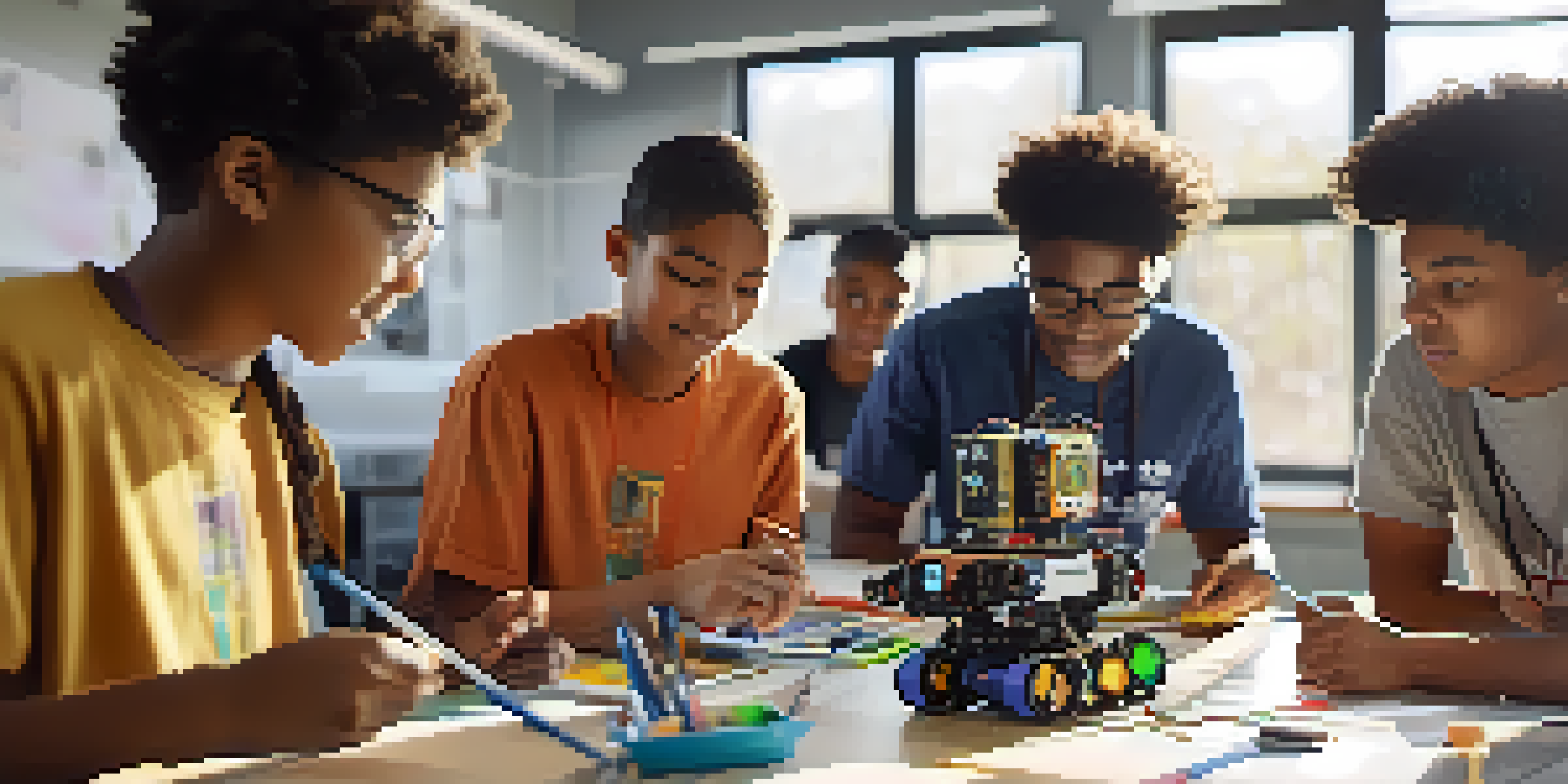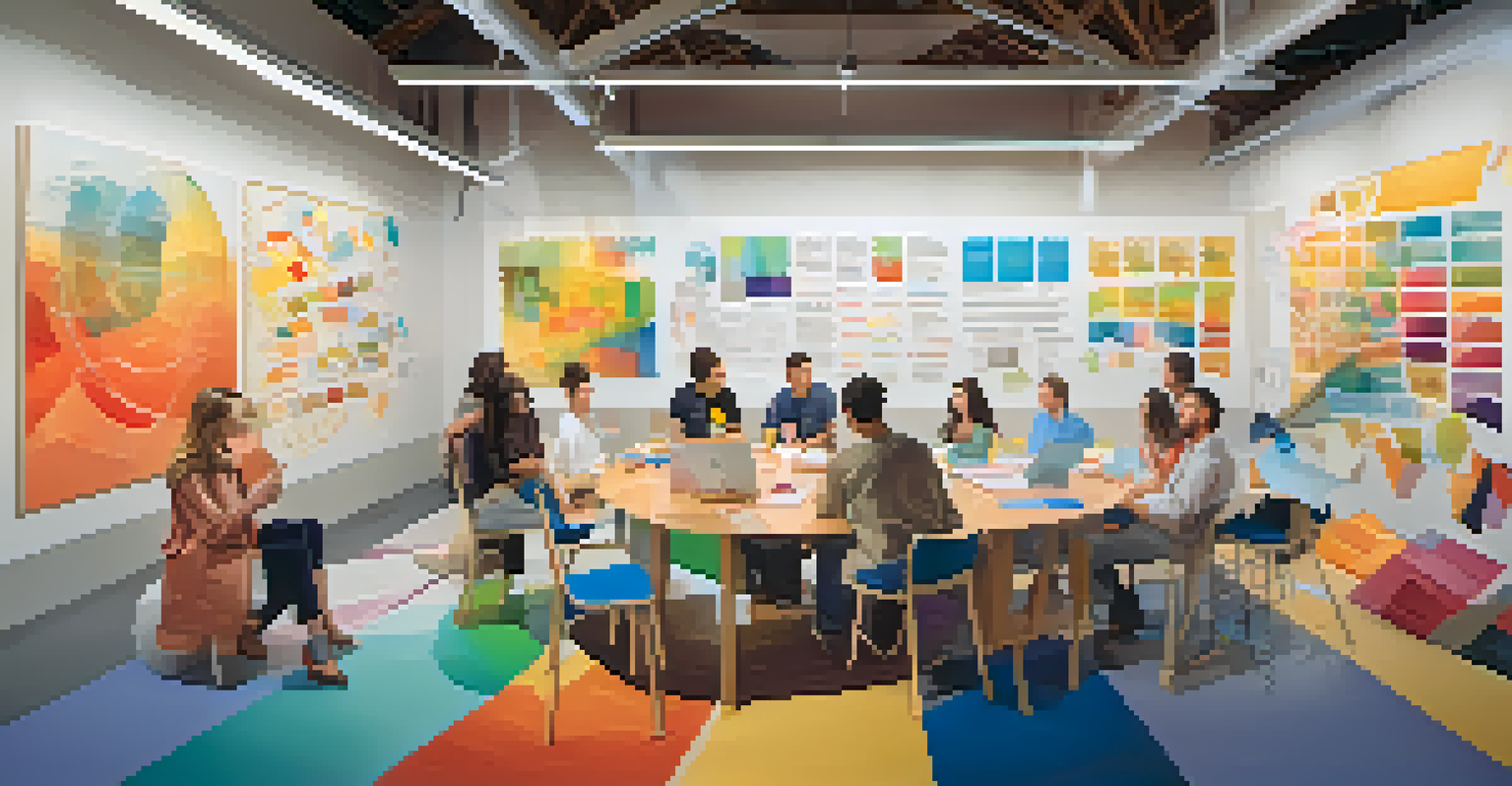Design Thinking in STEAM: A New Educational Paradigm

Understanding Design Thinking and Its Importance
Design thinking is a methodical approach to problem-solving that prioritizes empathy and creativity. It's about understanding users' needs and developing innovative solutions through iterative processes. In the context of education, it encourages students to think outside the box, fostering a collaborative and hands-on learning environment.
Design thinking is not just about what you create. It's about how you create it, and the impact it has on the world around you.
This methodology is particularly valuable in STEAM (Science, Technology, Engineering, Arts, Mathematics) fields, where complex challenges often require multifaceted solutions. By integrating design thinking, students not only learn technical skills but also develop critical thinking and communication abilities. It shifts the focus from rote memorization to a deeper understanding of concepts and real-world applications.
Ultimately, design thinking nurtures a mindset that embraces failure as a learning opportunity. This resilience is crucial in STEAM, where experimentation and adaptation play key roles. By fostering this mindset, we prepare students to tackle future challenges with creativity and confidence.
The Role of Empathy in STEAM Education
Empathy is at the core of design thinking, allowing students to understand and connect with the perspectives of others. In STEAM education, this means recognizing the diverse needs of users and stakeholders when developing solutions. By incorporating empathy into their projects, students learn to create designs that are not only innovative but also user-centric.

For example, a group of students working on a robotics project might conduct interviews with potential users to understand their challenges and preferences. This process not only enhances the students' technical skills but also sharpens their ability to see the bigger picture. As a result, their final product is more likely to meet real-world needs effectively.
Empathy Drives User-Centric Solutions
Design thinking emphasizes empathy, enabling students to create innovative solutions that address the diverse needs of users.
Empathy-driven design encourages collaboration and fosters a sense of community among students. When they learn to consider diverse viewpoints, they become more inclusive and culturally aware, making them better prepared for a globalized world. This human-centered aspect of design thinking enriches the STEAM curriculum, preparing students for varied future roles.
Integrating Creativity into STEAM Learning
Creativity is often viewed as the spark that ignites innovation, and design thinking plays a crucial role in cultivating this creativity in STEAM education. By encouraging students to brainstorm multiple solutions and explore unconventional ideas, design thinking helps unlock their creative potential. It allows them to approach problems from different angles and think divergently.
Failure is simply the opportunity to begin again, this time more intelligently.
For instance, in a design challenge, students might be tasked with creating an eco-friendly product. Instead of sticking to traditional materials, they might experiment with biodegradable options or repurposed items. This not only enhances their creative skills but also teaches them about sustainability and environmental responsibility.
Moreover, integrating creativity into STEAM learning prepares students for a future that values innovation. As industries evolve and new challenges arise, the ability to think creatively will be essential. By fostering this skill through design thinking, educators create an environment where students feel empowered to innovate and envision a better world.
Iterative Learning: Embracing Failure
One of the fundamental principles of design thinking is the iterative process, where students are encouraged to prototype, test, and refine their ideas. This approach not only enhances problem-solving skills but also teaches students that failure is a natural part of the learning journey. In STEAM education, embracing failure can lead to breakthroughs and unexpected solutions.
When students prototype their ideas and receive feedback, they learn to view criticism as constructive rather than discouraging. For example, a student might build a model of a bridge that initially collapses under weight. Instead of giving up, they analyze what went wrong and make improvements, ultimately leading to a more robust design.
Creativity Fuels Innovation in STEAM
By fostering creativity through design thinking, students learn to approach problems from various angles, enhancing their problem-solving skills.
This iterative process cultivates resilience and adaptability in students, essential traits for the fast-changing landscape of today’s world. By learning to embrace failure and view it as a stepping stone to success, students are better prepared for real-life challenges in their future careers.
Collaboration: The Heart of Design Thinking
Collaboration is a key component of design thinking, encouraging students to work together and leverage each other's strengths. In the context of STEAM education, this collaborative spirit not only enhances learning but also mirrors real-world scenarios where teamwork is essential. Students learn to communicate effectively, share responsibilities, and respect diverse perspectives.
For example, in a project where students create a mobile app, they might divide tasks based on individual strengths—some might focus on coding, while others handle design and user testing. This division of labor allows them to produce a more polished product while learning from one another in the process.
Additionally, collaboration fosters a sense of belonging and community among students. When they work together towards a common goal, they build relationships and develop social skills that are invaluable in any career. By integrating collaboration into STEAM learning through design thinking, educators prepare students for successful teamwork in their future endeavors.
Real-World Applications of Design Thinking in STEAM
One of the most exciting aspects of design thinking in STEAM education is its emphasis on real-world applications. Students are encouraged to tackle genuine issues faced by communities, businesses, or the environment, making their learning experiences more relevant and impactful. This connection to the real world not only engages students but also inspires them to become change-makers.
For example, students might collaborate with local organizations to address a community challenge, such as waste management. By applying design thinking, they can create innovative solutions, like a recycling program that incorporates technology. This not only provides hands-on experience but also instills a sense of responsibility and purpose.
Collaboration Enhances Learning Outcomes
Collaboration in design thinking prepares students for real-world teamwork by encouraging effective communication and respect for diverse perspectives.
By understanding how their work can effect change, students become more motivated and invested in their learning. Real-world applications of design thinking elevate STEAM education from theoretical knowledge to practical, meaningful action. This approach prepares students not just for careers, but for active citizenship in a complex world.
The Future of STEAM Education with Design Thinking
As we look ahead, the integration of design thinking in STEAM education promises to transform how we prepare students for the future. With rapid technological advancements and evolving job markets, the ability to think critically, creatively, and collaboratively will be paramount. Design thinking equips students with these essential skills, making them adaptable in the face of change.
Furthermore, as we continue to emphasize the importance of social and environmental responsibility, design thinking offers a framework for addressing these challenges. Students will be empowered to develop solutions that are not only innovative but also sustainable and ethical. This holistic approach to education prepares them to be conscientious leaders and problem-solvers.

In conclusion, the future of STEAM education lies in embracing design thinking as a core component. By fostering a culture of creativity, empathy, and collaboration, we can inspire the next generation of innovators who will shape a better world. This new educational paradigm not only enhances learning but also ignites a passion for lifelong discovery.